

Emergency Response Teams Combine Mobile Robots, Drones, and Dogs. No matter how much time and energy and money we put into a robot, it's going to be a very very very long time before we come up with anything that's anywhere close to as capable as a dog.
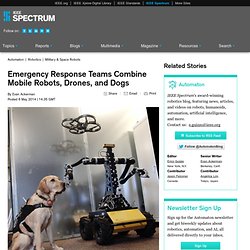
From a robotics perspective, dogs are utterly amazing: they're fast, efficient, able to cover all sorts of terrain, can understand both verbal and gestural commands, and they run on dog food. Dogs do have some limitations: they can't move rubble, and they're not that great at flying, either. Robots can do these things, but in a disaster scenario, the key is getting all these different pieces (robots, dogs, humans, and anything else) to work together in a coherent way. The Smart Emergency Response System (SERS) is trying to make this work, using a combination of "ground and aerial autonomous vehicles, drones, humanoids, human-operated telerobots, and trained search-and-rescue dogs equipped with real-time sensors" to save as many lives as possible in an emergency. Home - Humanitarian UAV Network. Using UAVs for Search & Rescue. UAVs (or drones) are starting to be used for search & rescue operations, such as in the Philippines following Typhoon Yolanda a few months ago.
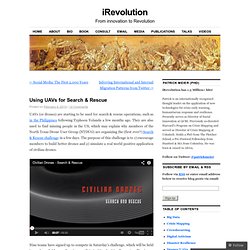
They are also used to find missing people in the US, which may explain why members of the North Texas Drone User Group (NTDUG) are organizing the (first ever?) Search & Rescue challenge in a few days. The purpose of this challenge is to 1) encourage members to build better drones and 2) simulate a real world positive application of civilian drones. Nine teams have signed up to compete in Saturday’s challenge, which will be held in a wheat field near Renaissance Fair in Waxahachie, Texas (satellite image below). The organizers have already sent these teams a simulated missing person’s report.
When the challenge launches, each team will need to submit a flight plan to the contest’s organizers before being allowed to search for the missing items (at set times). Using Crowd Computing to Analyze UAV Imagery for Search & Rescue Operations. My brother recently pointed me to this BBC News article on the use of drones for Search & Rescue missions in England’s Lake District, one of my favorite areas of the UK.
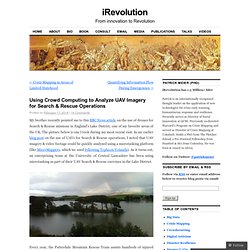
The picture below is one I took during my most recent visit. In my earlier blog post on the use of UAVs for Search & Rescue operations, I noted that UAV imagery & video footage could be quickly analyzed using a microtasking platform (like MicroMappers, which we used following Typhoon Yolanda). As it turns out, an enterprising team at the University of Central Lancashire has been using microtasking as part of their UAV Search & Rescue exercises in the Lake District. Every year, the Patterdale Mountain Rescue Team assists hundreds of injured and missing persons in the North of the Lake District. In the Philippines, drones are used for news reporting and rescue operations.
Since last year we’ve been seeing how the purpose of drones has moved outside the confinements of the military.
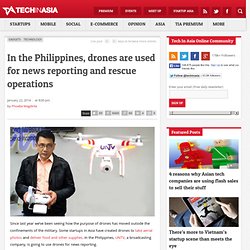
Some startups in Asia have created drones to take aerial photos and deliver food and other supplies. In the Philippines, UNTV, a broadcasting company, is going to use drones for news reporting. The network reports that it has already used the drones for a number of news reports, including providing aerial video footage of areas hit by typhoon Haiyan, and even in daily traffic reporting. UNTV CEO Daniel Razon says that using drones for news reporting is a trial for a greater purpose – rescue operations. The Philippines is often hit by natural disasters, so Razon says the network is acquiring drones that can carry life buoys and water to affected areas.
These Drones Will Save Your Life. By Cormac Eubanks - January 17, 2014 The word “drone” usually conjures up negative images of invisible eyes in the sky and shadowy, unknown forces.
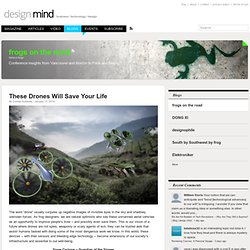
As frog designers, we are natural optimists who see these unmanned aerial vehicles as an opportunity to improve people’s lives – and possibly even save them. This is our vision of a future where drones are not spies, weaponry or scary agents of evil; they can be trusted aids that assist humans tasked with doing some of the most dangerous work we know. In this world, these devices -- with their sensors and bleeding edge technology -- become extensions of our society’s infrastructure and essential to our well-being.
Snow Cyclops – Guardian of the Slopes The Snow Cyclops is a multi-purpose mountain Unmanned Arial Vehicle. The Cyclodrone – Making Solo Bicycle Rides safer. Tijuana, Mexico to Adopt UAVs for Emergency Response. Disaster drones: How robot teams can help in a crisis. 22 July 2012Last updated at 22:39 ET By Dougal Shaw Technology reporter Professor Nick Jennings explains why and how he is testing disaster drones An ominous plume of black smoke hangs over east London.
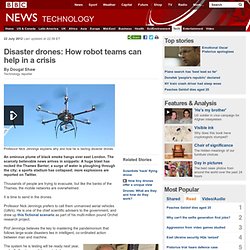
The scarcely believable news arrives in snippets: A huge blast has rocked the Thames Barrier; a surge of water is ploughing through the city; a sports stadium has collapsed; more explosions are reported on Twitter. Thousands of people are trying to evacuate, but like the banks of the Thames, the mobile networks are overwhelmed. It is time to send in the drones. Professor Nick Jennings prefers to call them unmanned aerial vehicles (UAVs). Prof Jennings believes the key to mastering the pandemonium that follows large-scale disasters lies in intelligent, co-ordinated action between man and machine. Prof Nick Jennings heads the Agents, Interaction and Complexity Group at Southampton University. How UAVs Are Making a Difference in Disaster Response.
I visited the University of Torino in 2007 to speak with the team developing UAVs for the World Food Program.
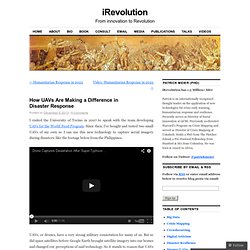
Since then, I’ve bought and tested two small UAVs of my own so I can use this new technology to capture aerial imagery during disasters; like the footage below from the Philippines. UAVs, or drones, have a very strong military connotation for many of us. But so did space satellites before Google Earth brought satellite imagery into our homes and changed our perceptions of said technology. So it stands to reason that UAVs and aerial imagery will follow suit. This explains why I’m a proponent of the Drone Social Innovation Award, which seeks to promote the use of civilian drone technology for the benefit of humanity. I recently spoke with one of the Huginn pilots who was in Tacloban. I’d like to see closer collaboration between the Digital Humanitarian Network (DHN) and groups like DanOffice, for example. This platform was used in Haiti with the above drones.